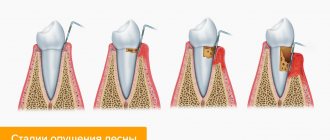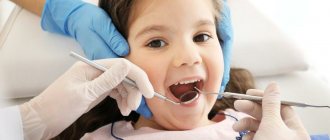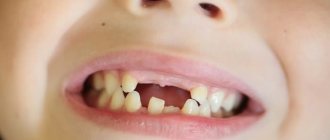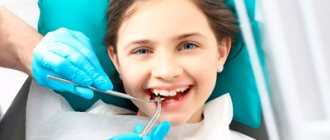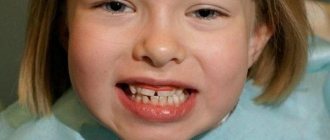The first reaction of parents who notice that their child is growing a second row of teeth is natural fear. In dentistry, it is generally accepted that there are two causes of pathology:
- abnormal growth of molars;
- polyodontia or supernumerary teeth.
Normally, permanent teeth replace baby teeth only after the latter fall out. The germ of the molar tooth stretches upward, thereby contributing to the destruction of the roots. With some features of jaw development, this does not happen, which is why the second row appears.
Reasons for the growth of the second dentition in a child
Double or “shark” teeth in children appear when the baby tooth and the rudiment of the molar are located at different points in the oral cavity. When a new set erupts, the baby tooth remains in place. A tooth grows above a tooth, which not only does not look aesthetically pleasing, but also interferes with the development of the rest of the row.
The most common reason why teeth do not change is improper breathing. A lot depends on how a child breathes. Breathing disorders lead to problems with bite, deterioration of posture and changes in facial shape.
A child’s jaw develops correctly only when he breathes correctly through his nose. The tongue in this position presses on the palate from the inside. A natural semicircular shape of the jaw is formed, in which there is enough space for all the molars. This is why it is so important to teach your child to breathe through his nose to prevent the growth of the second row of teeth.
Why didn't my baby tooth fall out?
The structure of temporary and permanent teeth has certain differences. Dairy teeth have the same shape as molars, but they are smaller in size, their roots are much shorter, and they grow in the amount of only 20 pieces versus 32 permanent ones, including wisdom teeth. The service life of “children’s” teeth is also short: their roots begin to dissolve (dentists say “resorb”) approximately 2 to 3 years after they are fully formed. The process begins from the area where the crowns of the permanent teeth growing underneath touch them.
However, it happens that the rudiments of molars do not form for some reason. In this case, the roots of the milk teeth most often dissolve under the influence of the rudiments of adjacent permanent teeth. But sometimes this does not happen, and then “children’s” teeth are preserved in adults - doctors call them persistent, from the Latin persistere - to remain, to remain.
The reasons for the absence of permanent tooth buds can be different. Sometimes these are hereditary characteristics, metabolic disorders or disorders of the endocrine glands, trauma and osteomyelitis of the jaws. Chronic and acute inflammatory processes in baby teeth, in particular, periodontitis that is not cured in a timely manner, can also lead to damage and death of the rudiments of permanent teeth.
It also happens that the rudiments of permanent teeth, although they are formed, lie very deep, without touching the roots of milk teeth. This may be caused by insufficient space or misalignment of the permanent tooth. In these cases, milk teeth can remain in an adult.
Supernumerary teeth in children
The appearance of additional tooth buds is rare, occurring in only 2% of cases. The anomaly is associated with a disorder of embryonic development. A tooth that appears above a child's tooth is usually removed. But this does not always happen: if the tooth does not disturb the shape and aesthetics of the dentition, the dentist can leave it.
Sometimes supernumerary teeth are located outside the dental arch. The appearance of a tooth on the palate of a child is rare, however, this is no exception. There is no need to be afraid of this: it does not affect your health in any way. The Natadent clinic has a pediatric orthodontist who will help solve this problem quickly and painlessly.
The first stage of treatment for tooth transposition
The first step was to move the crown of permanent canine 1.3 into place. Naturally, primary canine 5.3 was removed before installing braces at the stage of sanitation of the oral cavity. For this, a NiTi spring was used to open from the bracket on the second premolar to the canine crown on one side, and light traction with an elastic chain on the other.
What to do if the child’s teeth grow in the second row?
When a doctor sees a tooth above a patient’s tooth, he immediately understands what’s wrong. First, the orthodontist removes the baby tooth. After this, the permanent tooth will move into place on its own under the action of the tongue muscle, if there is enough space. But what to do if a child has a lack of space for molars?
The primary task of the dentist and parents will be to restore normal breathing. At this stage, it is necessary to “retrain” the muscles of the mouth to work differently. This is where trainers or mouthguards come to the aid of specialists.
Orthodontic appliances solve several important problems:
- train the muscles of the oral cavity, stimulating their natural development;
- correct the direction of development of the child’s jaws;
- correct the position of the tongue in the oral cavity;
- teach the child to breathe through the nose;
- get rid of bad habits.
Wearing trainers is most often considered as a preparatory stage. After this, more serious orthodontic treatment begins with the use of braces. However, here the first step is the most important, since the effectiveness of further work depends on it.
Let's consider a clinical example of transposition correction using orthodontics
Patient N., 14 years old, came with her mother to the dental clinic. Complaints were made about the incorrect location of the canine on the upper jaw on the right. We already had a panoramic radiograph in hand, which complemented the analysis of the clinical situation in the oral cavity. To clarify the diagnosis and determine the optimal treatment plan, the patient was referred for a computed tomography scan of the jaws
After analyzing the diagnostic data, it was found that the root of the first premolar 1.4 is inclined towards the persistent primary canine 5.3, and the root of the permanent canine 1.3 is projected into the area between the roots of the premolars. Consequently, the situation was complicated by the fact that it was necessary not only to move the crowns, but also to “separate” the roots of the canine and premolar in their places.
When discussing the treatment plan with the patient and parents, a clear decision was made: to put the teeth in their places, despite the duration and complexity of the correction. The treatment method involved fixing a metal brace system initially only on the upper jaw, and after moving the crowns and roots, installing a brace system on the lower jaw for final correction and detailing the position of the teeth.
How to understand that a child is at risk of growing teeth in two rows?
Attentive parents should monitor the process of teeth growth and loss. The change of dentition begins at 6-8 years: the first to fall out are the central and lateral incisors. At 9-11 years old, the lower canines change. By the age of 10-12, the upper canines and small molars grow. The formation of the bite ends at the age of 13-14 years.
A child’s tooth grows above the tooth when the baby tooth does not leave its place in due time. In this case, parents should definitely consult a doctor. The earlier the pathology is detected, the easier it is to correct the child’s second dentition.
You don’t have to wait for your baby teeth to suddenly fall out on their own! If you notice that your child’s molars are cutting in, but his baby teeth aren’t even loose yet, take him to the dentist. With “shark” teeth, not only the appearance, but also the shape of the jaw is disrupted.
How do “eights” erupt?
Wisdom teeth are the last teeth to erupt. Sometimes at 18–20 years old, but more often at a later age. In addition to the fact that these are the largest teeth, there are cases when they are located in the jaw bone not vertically, but at an angle. Therefore, problems most often arise with their eruption: the tooth does not grow upward, but to the side, pressing on the root of the nearest tooth, causing pain and inflammation. Often, to avoid such problems, wisdom teeth are removed without waiting for them to fully erupt.
Wisdom teeth often cause problems when they erupt
But if the tooth grows more or less without problems, the person does not see a dentist; there is no indication for tooth extraction. And then it turns out that due to the growth of molar No. 3, the front teeth have moved.
“Eights” are large teeth, and if there is not enough space in the dentition, they move neighboring teeth, and even the front ones.
Crowded teeth
Is it possible to remove a tooth and return everything as it was?
If you remove a tooth, nothing will change. Orthodontist patients know that after treatment a consolidation stage is needed, otherwise the roots of the teeth will begin to move to their old familiar place. It takes at least two years for the teeth to adjust and strengthen in their new position, and to do this they are held in place with the help of retainers and aligners.
During orthodontic treatment, the pressure from braces or aligners is much greater than that exerted by the growing wisdom tooth. Therefore, with an orthodontic system, teeth are moved within a few months, and the first results are visible within a few weeks.
Aligners correct the position of teeth in a few months
A growing molar erupts very slowly, over 2–3 years, and puts pressure on neighboring teeth, causing them to move. The process occurs almost imperceptibly, the teeth shift by fractions of a millimeter per month. During this time, they get used to the new (wrong) position. The ligamentous apparatus that supports the teeth is rebuilt to a new position, and the bone tissue around the roots is strengthened. And even if wisdom teeth are removed, it will not be orthodontically beneficial. Neither from a health point of view, nor from an aesthetic point of view.
Mouthguard as a preventive measure for the second dentition
In dental practice, mouth guards are worn by children over four years of age. At this age, the child is already consciously approaching wearing a trainer and can wear it for a long time. The device is made according to individual casts, taking into account the characteristics of jaw development. The material from which the mouthguard is made is soft and does not injure the mucous membrane.
From the age of two, children can wear removable plates to correct bad habits. If a child often sucks a pacifier or fingers, his bite does not develop properly. These children are more likely to have teeth growing in two rows. A soft plate will help avoid this.
In our clinic, parents trust doctors with their most valuable asset – their children. You can rely on our specialists in any situation. To confirm these words, we publish reviews from our grateful clients.
Natadent specialists know how to win over the youngest patients. Most guys leave the dentist's office without the same fears. True professionals in their field not only master their tools flawlessly, but also make every trip to them as comfortable as possible.
The second stage of transposition treatment is moving the teeth into place.
Next, it was necessary to move the crown of the first premolar 1.4 from the palatal position and the reverse overlap to its rightful place. This required the separation of the bite with onlays. And, of course, the long and labor-intensive stage of normalizing the position of the tooth roots began. It is at this stage of treatment that the canine root is partially located outside the alveolar process of the upper jaw and, accordingly, the risk of gum recession is high. After a year and a half (!) of treatment, we managed to move the crowns and roots of the teeth to the correct position. And the third stage of treatment began

